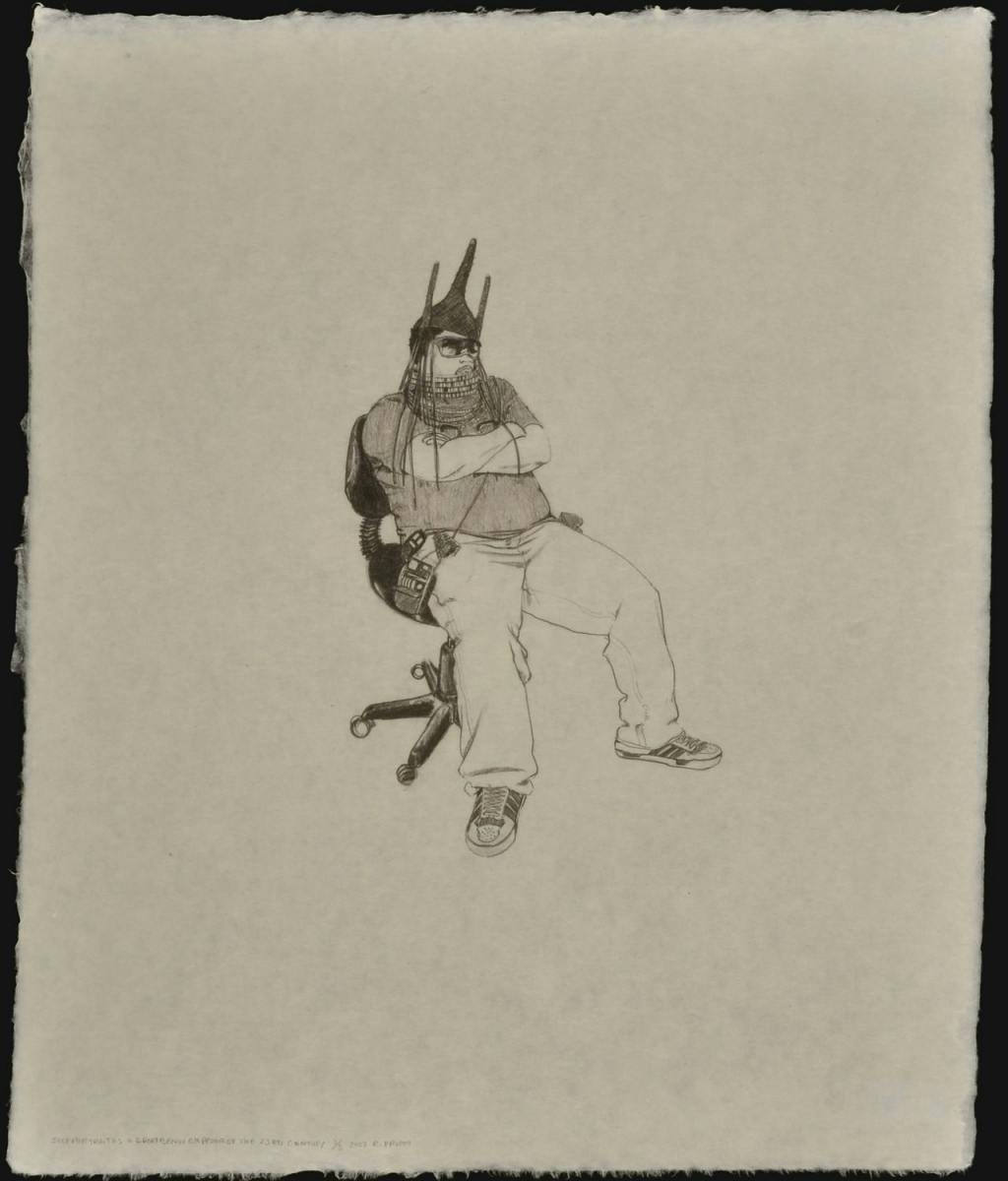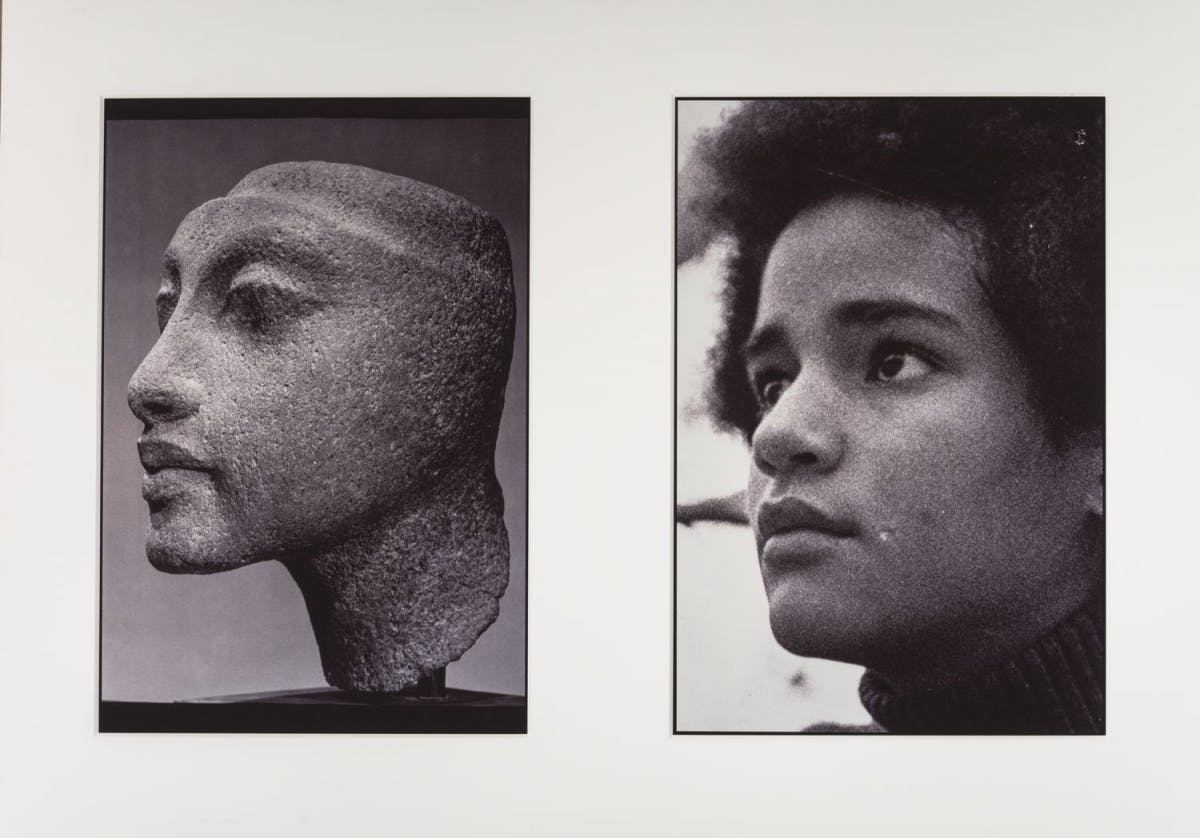Diaspora


Scattered by migrations, voluntary and not, global Black populations have long contended with efforts to write them out of history. Along with the colonial impulse to capture and control vast swaths of already occupied land, the project of cultural erasure undergirds the expansion of empire. The presence of a western art historical canon is only made possible through exclusion. For every Caravaggio, Monet, and Picasso, there are countless artists whose practices have been overlooked or intentionally erased. The narrative of progress surges forward unflinchingly, from the “white” marble statues of classical antiquity,1 to the technical brilliance of the Renaissance, and to the many ensuing “-isms” that make up the prevailing history of art. Galleries, scholars, and museums alike smooth out and patch over aberrations in this linear story; when African art does appear in the canon, it is often in service of white artists’ practices, as with the mask-like faces that denote fear and revulsion in Picasso’s Les Demoiselles d’Avignon. In the face of this racist myth-making, a struggle for agency and authorship naturally arises.
In his 2016 book on diasporic arts and their relationship to modernism, Travel & See, art historian Kobena Mercer speaks to the task of addressing such challenges, detailing how, “Because white supremacism posited that Africans were entirely stripped of an original culture by the Middle Passage, African American artists were obliged to refute such racist assumptions.”2 Countering geographic dislocation and attempts at eradicating and looting aesthetic traditions, many artists of the Black diaspora turn to the cultures, art, people, and geographies of Africa to convey and reclaim relationships to the continent within their work. This interest is not new. From Edmonia Lewis’s 1876 sculpture of Cleopatra to Alain Locke’s early-twentieth century calls for increased appreciation of African aesthetics, Black artists have long sought to stake a claim to their rich cultural heritage.
As the civil rights and Black Power movements spread in 1960s America and beyond, further attention to diasporic artists’ African roots took hold. The rich cultural traditions of West and Central Africa, particularly masks, imparted critical inspirations. Artists like Romare Bearden, whose collage Prelude to Farewell (1981) features a figure with a highly stylized face, admired the formal qualities and expressive potential of masks. The collage is distinctly tactile, echoing the way a mask occupies three-dimensional space, while remaining adhered to the page. Additionally, the medium prompts consideration of the artist’s hybrid heritage—at once an American and an African American, and reflecting this dual experience by carefully piecing together the figures in his work. As Ralph Ellison wrote in a 1977 essay on Bearden’s work,
“His combination of technique is in itself eloquent of the sharp breaks, leaps in consciousness, distortions, paradoxes, reversals, telescoping of time, and surreal blending of styles, values, hopes and dreams which characterize much of Negro American history... his figures are expressive of a complex reality lying beyond their frames. While functioning as integral elements of design, they serve simultaneously as signs and symbols of a humanity that has struggled to survive the decimating and fragmentizing effects of American social processes.”3
Elizabeth Catlett’s Mask (c. 1970) adopts a loose resemblance to its African counterparts, engendering solidarity through shared cultural heritage and using the form to convey the messages found in the newspapers adhered to the interior of the piece. Catlett created this work with a Black American audience in mind. Moving beyond a formal appreciation for masks, “Catlett deployed African art as a communication strategy to connect with her desired viewers.”4 The form calls upon the common African history of globally dispersed diasporic people, thus pulling them in closer to the work. Drawing this collective past into the present, Catlett’s mask primes her audience for the radical political messages on the work’s interior, including “Libertad Para Angela Davis!!” and “Democracy for Whom?”


Others recreated more specific traditions; of steam irons, like the one repurposed in Steam’n Hot (1999), artist Willie Cole says, “right away I saw it as an African mask, more specifically a Dan mask.”5 The face of the iron mirrors the almond-shaped outlines often found in the masks from this Ivorian and Liberian ethnic group. Cole’s interest in these parallel forms also appears throughout his series of “scorches,” in which he uses an iron’s heat to sear the imprint of a mask on to paper, establishing visual similarity to African masks and thematic connection to the histories of domestic labor in his family. Similarly, Robert Pruitt’s Self Portrait as a Great Benin Emperor of the 23rd Century (2007) inscribes the artist, sitting in an office chair, with a regal Beninese heritage that at once looks to the past and future, as the title suggests. He merges symbols—an African headpiece, Adidas sneakers, an office chair—to create a distinctly contemporary, fundamentally African American image.
Turning to the northeast of Africa, the ancient kingdoms of Egypt occupy a distinct niche in the minds of many African Americans. Perhaps the only African kingdom commonly mentioned in the same breath as ancient Greece or Rome, Egypt offers a well-documented and highly visible legacy in the form of its extant art and architecture. Avel C. de Knight’s Untitled (from Pyramid series) (c. 1974) offers a glimpse at these monumental remnants, with a Black man reclining in front of a pyramid and passing travelers. Lorraine O’Grady’s Sisters II (L: Nefertiti’s daughter Merytaten, R: Devonia’s daughter Candace), from the "Miscegenated Family Album" (1980/1988) pairs an image of the artist’s niece with one of the Egyptian queen Nefertiti’s daughters, tethering a contemporary African American existence to an ancient African one. In spanning time and space to source the images of this pairing, O’Grady draws royal Egyptian history into the present.


Zooming out to view the continent from afar, Fred Wilson’s Atlas (1995) envisions the diaspora, marked by pins on a globe upheld by a stereotypical minstrel figurine recast as the Greek Titan Atlas. The spread is vast, spanning continents as the globe swells with visible weight upheld by the bending Atlas beneath. Fatimah Tuggar uses a composite vantage point in her print Untitled (Army) (1996), which presents a troubling scene of miniature soldiers encroaching on a woman making food with her children. The soldiers rappel from helicopters and crouch with rifles drawn, instilling in the work an air of imminent danger. Rather than showing movement out of the continent, like Wilson, Tuggar depicts an invasion in, prompting us to consider just one of the many reasons behind the global dispersal of Black people.
Other artists use portraiture to explore the experiences of diasporic subjects. In visualizing themselves or someone else in a portrait, Black artists can reclaim the act of representation, offering a vision of blackness established on their own terms. A self-portrait, Zanele Muholi’s Bona, Charlottesville (2015), from the series “Somnyama Ngonyama,” depicts the artist lying naked on a bed, looking at themself with a handheld mirror. The image conveys deep intimacy. A routine moment rarely seen by others, viewing the act of regarding oneself in the mirror prompts considerations of beauty standards and the converging experiences that might affect one’s self-image. Muholi spoke to these themes, saying:
“The series touches on beauty, relates to historical incidents, giving affirmation to those who are doubting — whenever they speak to themselves, when they look in the mirror—to say, ‘You are worthy, you count, nobody has the right to undermine you: because of your being, because of your race, because of your gender expression, because of your sexuality, because of all that you are.’”6


Lastly, Malick Sidibé’s The Wannabe Musician Behind His Car (1971) offers a glimpse at post-Independence Mali. A young man, guitar in hand and smiling wide, leans on the back of his car. He emblematizes an Africa in flux, with numerous nations fighting for liberation from colonial rule. His eyes gleam at the camera. He is confident and he is free.
This essay expands on Collection in Context: Diaspora. To explore more works in our collection, read all our Collections in Context here.
Notes
1) Sarah E. Bond, “Why We Need to Start Seeing the Classical World in Color,” Hyperallergic, June 7, 2017, http://hyperallergic.com/383776/why-we-need-to-start-seeing-the-classical-world-in-color/.
2) Kobena Mercer, Travel & See: Black Diaspora Art Practices since the 1980s (Durham: Duke University Press, 2016, Kindle Edition): Chapter 12: Diaspora Aesthetics and Visual Culture.
3) Ralph Ellison, “The Art of Romare Bearden,” The Massachusetts Review 18, no. 4 (1977): 673–80.
4) Dalila Scruggs, “Activism in Exile: Elizabeth Catlett’s Mask for Whites,” American Art 32, no. 3 (September 1, 2018): 2–21, doi.org/10.1086/701613.
5) Willie Cole, “Willie and the Scorch,” Willie Cole, accessed January 30, 2023, williecole.com/scorches.
6) Maurice Berger, “Zanele Muholi: Paying Homage to the History of Black Women,” New York Times, December 3, 2018, sec. Lens, nytimes.com/2018/12/03/lens/zanele-muholi-somnyama-ngonyama-south-africa.html.